![]()
Often a new ham’s first radio is a handheld transceiver (HT). A HT represents the lowest-cost entry point to amateur radio and is relatively easy to set up and use. Your first on-air experience as a licensed ham may involve a HT on a local VHF/UHF repeater, and that’s fine.
But don’t settle for just a HT as supplied by the manufacturer for your early ham radio experience. You are almost certainly going to be frustrated and disappointed at its performance to the point of giving up on ham radio and wondering why all these hams are so enthusiastic about the hobby.
Don Keith N4KC makes this point eloquently in his ‘HT Trap’ article where he discusses how easily a new ham can get discouraged with amateur radio because of the limitations of a stock HT. I have observed this as well while helping new hams get set up in a local EmComm organization.
Huge improvements in HT performance or ease of use can be accomplished with three accessories.
First and foremost is the antenna. As mentioned in our antenna presentation, the antenna makes the most impact in radio communications. The stock or factory ‘rubber duck’ antenna is a very poor performer. Replacing it with a longer whip will allow you to hit repeaters better and extend simplex range.
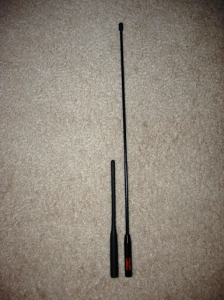

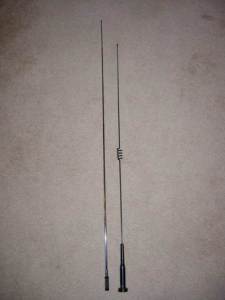
Even better, connect your HT to a permanent indoor or outdoor J-pole or Yagi via coaxial cable. This is not easily portable but some antennas can be moved.
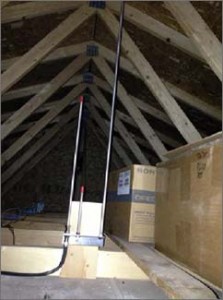
In cases where you are situated in a low-lying area or have large obstacles (buildings, trees), an external antenna mounted high is required for effective communication.
Even a mobile antenna on a cookie sheet will give you better performance indoors than the rubber duck.
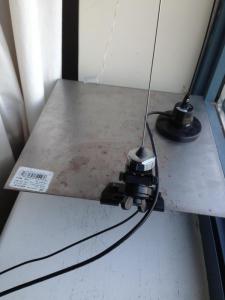
When using a vertical whip, a rat tail/tiger tail counterpoise will also improve performance.
Second is a RF power amplifier. Most HTs kick out 5W or so of transmit power, which isn’t much, particularly when paired with a poor antenna. This relatively low power level is what keeps HTs manageably small and light without draining the battery.
Compensating for a poor antenna with more power can really help; the combination of better antenna and more power will solve most HT limitations. VHF/UHF power amps typically provide 25-75W output, comparable to a mobile rig.
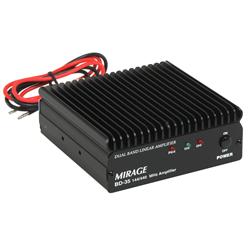
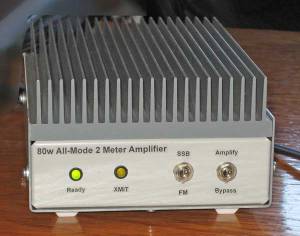
RF amplifiers require an external power supply, usually 12VDC. However, those are useful for many station accessories so you may (or should) have one anyway, and in a car you have the 12Vsupply built in. With a RF amp you will almost certainly be using a mobile antenna or J-pole or Yagi with a coax cable feedline.
Besides cost and power requirements, one drawback to external RF power amps is that they are not practically portable. They are easily mobile, however, and a good way to make a respectable vehicle radio out of a HT. Power amps are more practical at home where you need/want more power than your HT can provide.
Third is a hand microphone and/or boom mic headset. Not as much a performance enhancement as a convenience feature, having a separate small hand or boom mic means you don’t have to shove the HT into your face to speak into it.
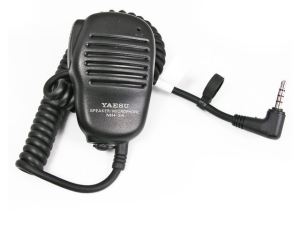
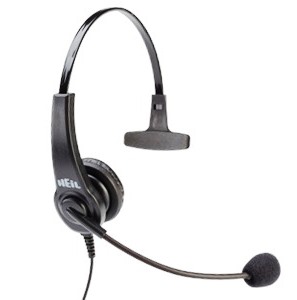
You can try two or three of these improvements, but even better than a RF amp and hand mic would be to invest in a mobile transceiver that can be used both in your vehicle and docked in your shack with a permanent VHF/UHF antenna setup.
Sure, it will cost a bit more money to buy accessories and/or radios that will perform better than a stock HT. But these will let you experience short-range ham radio without the discouraging performance limitations. Remember, VHF/UHF communications are limited to line of sight with the other station or a repeater, meaning you need decent antennas and reasonable power levels in many cases.
Beyond all this your ham radio experience will expand greatly when you purchase a HF radio and get an antenna set up for it. Then you can explore much more of what our hobby has to offer, allowing you to communicate over greater distances using various modes to suit your fancy (voice, Morse code, digital/data, TV).
If your initial experience with ham radio has suffered because all you have is a HT with a rubber duck antenna, don’t give up until you have considered these suggestions.

This post made me pause and think a bit… I even made some notes. I have to figure out what antennas I can put in the attic that will help me in both the short and long term. Winter will soon arrive. I’m still new to my HT, but I’m using it! I’ve bought a FT-817 to learn over the winter, maybe with something in the attic… although initially I’ll likely just be using a mobile dual band antenna stuck on a file cabinet in a corner of the office/shack next to about 6′ of exterior windows. I’m a backpacker/hiker and will go mobile on the trail w/ the 817 next spring, so am working on getting all those details worked out, i.e. 5 AH AGM battery w/ solar supplement to haul around on the trail, and appropriate antennas. Planning to upgrade to General over the winter. Any suggestions? 😉 and thx for ur post!
LikeLike
Hi Mike,
Sorry, this slipped by me and I let your question go unanswered for months.
Assuming your Q is regarding portable antennas for hiking/backpacking, the answer is the same for both VHF/UHF and the HF bands with your FT-817. You want a compact, lightweight antenna to carry around that is easily deployed.
For VHF/UHF operation with a HT and/or your all-band/all-mode rig, you can build or buy a “SlimJim” roll-up antenna that easily fits in the palm of your hand yet gives excellent performance. I like this one you can buy on eBay for less than $30: http://www.ebay.com/itm/DELUXE-MODEL-ROLL-UP-2M-70CM-ROLL-UP-ANTENNA-WITH-10FT-COAX-J-POLE-SLIM-JIM/201468112301
Using a PL-259 to SMA adapter you can make it connect to your FT-817.
Now for HF operation when you upgrade to General it gets a little more complicated because you have to pack a longer, heavier antenna. A simple dipole is fairly compact and lightweight where you elevate the ends (horizontal) or just the center (inverted vee) up in trees or other natural supports so you don’t have to pack a mast and guy wires. There are other portable antennas available commercially, just more expensive than a simple dipole.
Of course you’ll have to choose a band of operation to match your antenna length. 20m is a good choice for keeping it compact but having good propagation in daytime.
Best wishes on your General ticket and hope this helps,
Jim
LikeLiked by 1 person
I have two HT’s – one a Yaesu VX-7RB and the other a Baofeng B580T. The antenna on the Yaesu is fine, and I’ve got a Nagoya NA-771 on the Baofeng. But I’m also in an area with several easily accessible repeaters and lots of them are cross linked with other repeaters on other bands.
And the Yaesu does have 6m capability.
LikeLike